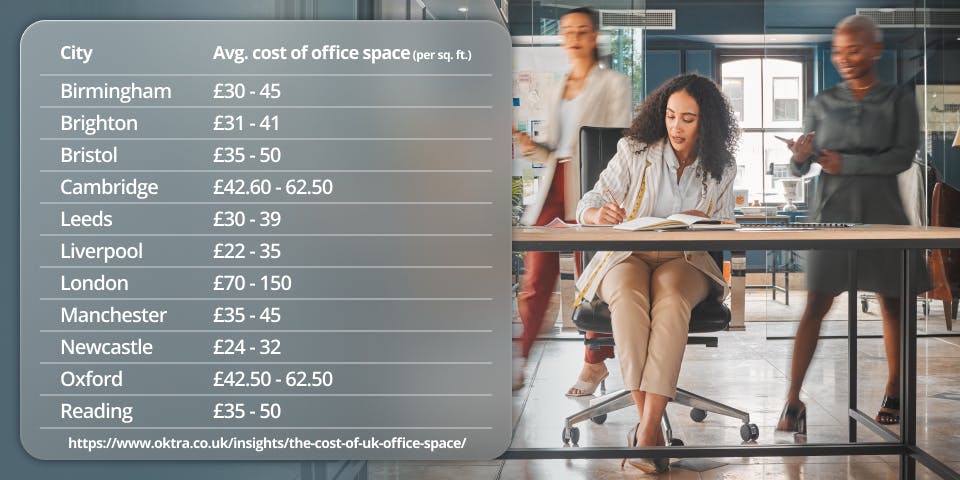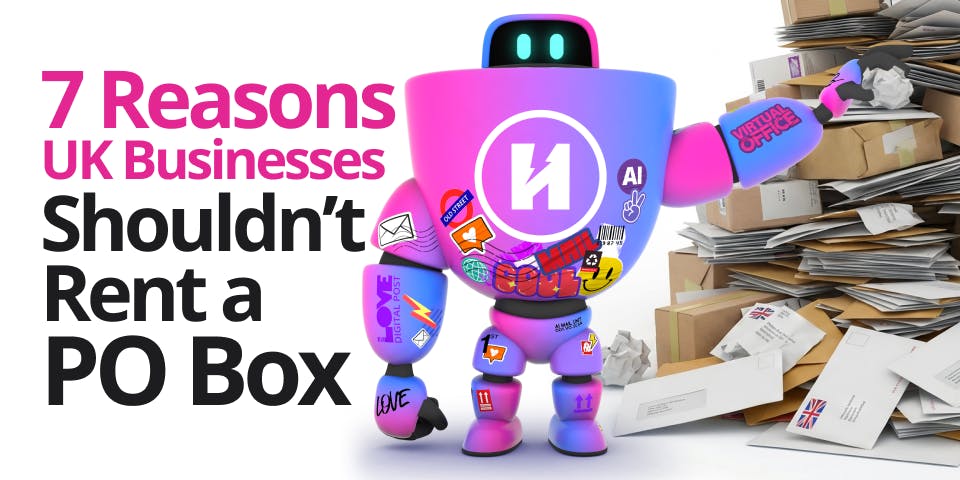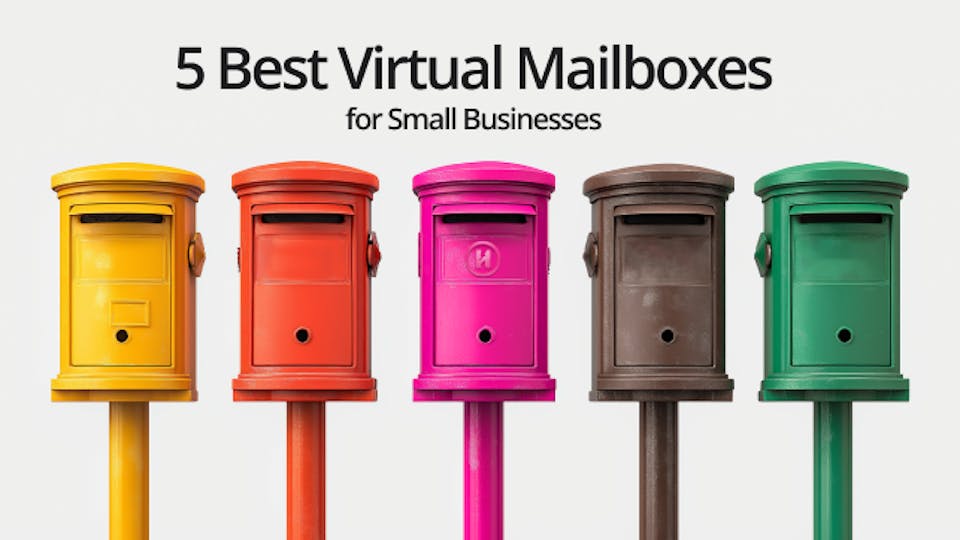25 June, 2025
Virtual Office vs Physical Office vs Coworking Space: Which is Best for Your Business?
Table of Contents
The last few years, accelerated by the COVID-19 pandemic, have seen a fundamental change in how we work, specifically, it has driven the growth of remote working. This triggered a fundamental shift in how people work; hybrid models & full-time remote, have joined the accepted ranks of job descriptions worldwide.

Those changes are now fully entrenched and accepted by employees and employers alike. This flexibility to work anywhere, prompts the question: ‘Do we really need to work from a single, fixed physical space anymore?’
In this article we’re going to tackle this important issue head-on, considering the benefits of virtual offices versus coworking spaces, as well as physical offices versus virtual offices.
Overview
Before we get started looking at the benefits of each solution, let’s define what is a virtual office and how they work.
As the name suggests, virtual offices aren’t based in a physical location. Typically, a virtual office is a service that’s provided by a vendor (such as Hoxton Mix) that provides your business with a professional business address and office-related services, without the expense of letting commercial space.
Virtual office services vary depending on the provider and cover a wide spectrum from the ability to temporarily rent a desk space through to a pure digital suite of office-related services. The spectrum of services should include a business address, director service address, mail handling and processing, phone services and other digital products. Physical space rental is also an option, but more linked to coworking spaces. Virtual office service providers will often include the option for desk, meeting room and physical space rentals.
Evolution of the traditional office
Ever since the development of the first purpose-built office, London’s The Old Admiralty Office, in 1726, technology has had a huge impact on our work environment—from the invention of the lightbulb allowing for longer working days to the launch of email in the 1990s.
No single advancement has had a greater impact than the internet, yet prior to 2020, only the most forward-thinking businesses considered anything other than hiring a dedicated commercial office space to act as the base for their business—the exception being startups that hadn’t yet become large enough to justify the investment.
According to the Office for National Statistics’ Annual Population Survey for 2019, just 12% of UK working adults reported working from home at some point in the week before the survey was conducted.
This all changed in 2020 during the first lockdown, and in 2021 during the third lockdown, when working from home peaked at 49% and 48% of all workers, respectively. Although home working declined significantly in the following 12 months, dropping to 25% in March 2022, it increased again from then on, hitting 40% in February 2023. According to recent data, this level of remote and hybrid working persists, with 41% of workers in the UK reporting to have worked from home at least for some of the time in March 2025.
Infrastructure and amenities
One of the obvious differences between a virtual office and a physical office is the amenities on offer.
While virtual offices boast all of the same digital infrastructure your business needs, they lack the dedicated office facilities of an office space. While there are drawbacks of not having some of these at your disposal there are also advantages, particularly not having to spend time or money maintaining them.
In this respect, coworking spaces can represent a good compromise. They can offer many of the same amenities your employees might want access to, while reducing the burden of maintaining them on you as an employer. However, there’s a downside to not having control over that infrastructure too.
Internet connection not fast enough for what you need? There might not be anything you can do about it. Toilets are out of order? There’s not a lot you can do if they’re taking too long to repair.
Technology integration
The availability of ultra-fast broadband in homes, as well as the proliferation of cloud computing technology, means that accessing all of the software and applications an employee needs from their private residence is quick and easy. Virtual collaboration tools like Microsoft Office 365 and Google Workspace, as well as digital communication tools like Zoom, Slack and virtual office phone numbers make remote operations simple.
The equipment and facilities on offer within traditional physical offices and tech-enabled coworking spaces will always be superior to an employee’s home, but the gap has closed significantly in the last decade, and business owners need to make an assessment of whether slightly faster connectivity is worth the extra investment.
Financial implications
When choosing between a virtual office, physical office and coworking space, cost will play a big part in the decision-making process.
While a virtual office address can be secured from as little as £19 per month, in the UK physical office space can cost up to £45 per square foot in the north of England, and as much as £150 per square foot in London.

When it comes to the cost of coworking spaces geography will also be a big factor, with an average cost per desk of £350 per month in London, but just £150 per month in Leicester and Nottingham.

The benefit of coworking spaces versus traditional offices is greater flexibility. However, most coworking space providers will require you to sign up for a fixed-term contract or commitment, which are typically shorter in length than an office lease. What’s more, you don’t have to rent the space all day, every day; instead, choose how many hours or days per week you wish to have access to it. Additional flexibility can sometimes come in the form of further provider locations across a city, geography or in some cases even nationally. This access is usually only available for an additional cost.
3 key considerations when deciding between virtual offices, physical offices and coworking spaces
In addition to amenities and cost, there are various other factors business owners need to consider when choosing between virtual, physical and coworking office spaces.
Address and location
When choosing a physical office location, whether that’s a dedicated office for your business or a coworking space, location is one of the most important factors. For example, what does the address say about your business, do your clients need to access it, how easy is it for your employees to commute to, and does the local area offer the amenities you need?
Of course, your employees won’t be commuting to a virtual office (although some providers, including Hoxton Mix, do offer meeting room bookings too), but one of the key virtual office benefits is that you can secure a professional business address without the expense. With the Hoxton Mix, your business will benefit from a genuine physical address located in Shoreditch, London, one of the most sought-after locations in the UK. The result is that your clients, employees, the HMRC and public-facing materials will all recognise your virtual address as the home of your business.
Reception and client-facing services
A virtual office provides your business with a professional and established address to put on your website, invoices, official business formation set-up with the HMRC, bank accounts and all other customer-facing materials. All of your mail will be processed by the virtual office service provider and sent to you either/digitally or physically. What about face-to-face interactions?
This is a common concern for business owners thinking about hiring coworking spaces or using virtual office services: What will my clients think? However, it’s important to remember that not all dedicated commercial office space is suitable for customer visits. What’s more, as we mentioned above, some virtual office providers also offer meeting room booking, and these locations will have a reception area that your guests can use while they wait for the meeting to begin. This is often the case for coworking spaces, too, so this shouldn’t be the reason you invest in a traditional office.
These reception services extend to phone calls too, with call forwarding available with virtual office plans and coworking space services as optional extras. At the Hoxton Mix, we also offer a virtual phone service, for example, that allows you to include a public-facing location-specific phone number.
Scalability and business growth considerations
Predicting and managing growth is one of the biggest challenges for businesses of all sizes, and one of the main downsides to traditional offices is that it can be hard to scale up and down quickly. Ultimately, we are talking about business flexibility.
Businesses often have to invest in more space than they need to allow them to grow into, meaning you’re always paying more than is necessary at any given time. This problem is made worse by the fact that the average office lease lasts 44 months according to data from Re-Leased.
Coworking spaces provide a greater degree of flexibility, with desks often available on rolling monthly contracts, but larger companies might find they need to commit to at least 12 months if they want a dedicated space within a coworking building.
By contrast, virtual offices offer the greatest degree of flexibility as the cost doesn’t increase as you grow. For example, with a virtual office plan from Hoxton Mix, you’ll pay £19 per month regardless of whether you’re a sole trader or employ 100 people. And given that the Hoxton Mix offers a single price plan including all you need for your virtual business, with the option for a few additional add-on services, your cost remains the same. By not tying yourself to a physical location, you’re also free to hire the best talent from all over the world.
Productivity and work environment
A study conducted by Microsoft found that 85% of business leaders found it hard to ‘have confidence that employees are being productive’ when working remotely.
This doubt over how hard employees work when not being watched is a key factor for owners when deciding on the working model for their business, but these fears have been found to be unfounded by other research. A report by Future Forum found workers with full schedule flexibility reported 29% higher productivity and 53% greater ability to focus, compared to workers with no ability to shift their schedule. Furthermore, a LinkedIn poll conducted by People Management last year found that almost three-quarters (73%) of employees say they’re more productive when working from home.
However, it’s important to remember that not everyone has a home environment that’s suitable for work, whether that’s because of a noisy household, limited space or technical limitations. Although 73% of respondents to People Management’s poll said they were more productive working from home, that still leaves 27% feeling the opposite—a not insignificant proportion. With this in mind, when choosing working models, you have to consider what’s best for current employees as well as future hires.
If your business deals with particularly sensitive data, this will also be a consideration. Do you trust the internet security of your employees' home office setups? Although remote IT and monitoring software is available, you don’t have control over who can come in and out of your employees' homes or coworking spaces, unlike with a dedicated office.
Collaboration and team dynamics
Although the data shows that workers consider themselves to be more productive when working from home, other issues around team collaboration and dynamics are worth considering.
Organisational culture
A parliamentary report from October 2022, ‘The impact of remote and hybrid working on workers and organisations’, identified developing and maintaining a strong organisational culture as a major challenge for organisations.
Regular online check-ins and team meetings can help, but arguably nothing can be a substitute for face-to-face interactions when it comes to building personal relationships between colleagues, or line managers and their direct reports. When you sign up for the Hoxton Mix Virtual Office plan, you also unlock big discounts for a variety of additional digital services that will help connect your teams, such as Google Workspace, Slack and Notion.
This is a question of in-office versus hybrid versus remote working models, rather than necessarily a question of virtual office versus traditional office versus coworking space, but clearly there’s a direct link here. And digital tools can help to manage most areas we have discussed.
A physical space with mandated time in the office maximises face-to-face contact—albeit at the expense of work-life balance and employee wellbeing—while a virtual office does not, although choosing a provider that offers meeting rooms for in-person events does help to address this significantly. Indeed, organisations can still develop a strong organisational culture when they choose the virtual office-remote working model; they just have to invest more effort in doing so—something all successful businesses should be putting thought into anyway.
Collaboration patterns and effectiveness
Building personal connections is important for effective collaboration, but this is more difficult when everyone works remotely, either some or all of the time.
Although technology makes it easier than ever before to collaborate digitally, the parliamentary report mentioned above still found that effective collaboration was one of the key challenges posed by hybrid and remote working models, as well as staff feeling more disconnected from their work organisations.
Networking and professional community
One of the benefits of coworking spaces compared to virtual offices or traditional offices is the opportunity to network with the professional community that shares the building. This might include special events, as well as simply being able to network with people in communal areas.
There’s also a concern that remote and hybrid working can lead to employee isolation, which has consequences not just in terms of mental well-being but also professional development. It’s harder to learn from our colleagues when we’re not in the same room and talking about work challenges and successes on a regular basis, but this can be mitigated with some planning and organisation.
Businesses using remote and hybrid working models should arrange team away days, online sessions dedicated to professional development and invest in training resources for remote employees.
Flexibility and personal preferences
Organisations need to consider the best ways of working for the business, but they also need to consider the personal preferences and expectations of their employees.
The ability to work from home, even if it’s for some of the time, is desired by 79% of workers, and failing to offer it is going to impact your ability to hire the best people. And there’s a diverse variety of reasons for employees to want this flexibility, with 78% citing improved work-life balance, 53% saying there are fewer distractions, 52% that they complete tasks faster, and 47% reporting better well-being.
Remote and hybrid working, something more likely to be found within organisations with virtual offices or that use coworking spaces, is more accommodating of diverse work styles and is more adaptable to personal circumstances and life changes. This isn’t to say a business operating out of a traditional office can’t instigate remote working, but the high cost of commercial space can put pressure on leaders to make sure it’s being used.
Suitability for different business types
Although not suitable for every business, a virtual office can provide many of the benefits of a traditional office without the cost, while advances in remote working technology make it more viable than ever before.
We've included a summary of physical offices vs virtual offices vs coworking spaces below in the table.
To find out more about why so many organisations are using Hoxton Mix’s virtual office services, get in touch with the team today by phone or email, or pop by for a chat at our Old Street location. We’re just a five-minute walk from the Old Street tube station and are more than happy to talk with business owners about how we can help.
| Consideration | Physical office | Virtual office | Coworking space |
|---|---|---|---|
| Infrastructure | On-site | Digital options available | On-site offering will vary depending on provider |
| Office amenities - toilets, printers, scanners, etc | On-site for all | Not provided | On-site offering will vary depending on provider |
| Internet software | On-site and limited beyond internet | Ultrafast broadband in residential homes and assortment of virtual collaboration tools | Only internet included as standard |
| Costs & commitment | High & inflexible | Low & flexible | Medium and semi-flexible. |
| Client-facing services | On-site, sometimes part of the offering if provided in a business centre. Non-dedicated. | No in-person reception team, but virtual phone call forwarding available | Often includes reception staff, although not dedicated to your business and services will vary. |
| Scalability | Hard to scale up and down as required | Cost doesn’t increase as business grows | Greater scope for scaling vs physical offices, but businesses might find themselves locked into contracts |
| Time to set-up | Slow & costly | Fast, flexible and lowest cost option. | Fast, flexibility dependent on provider & medium expense. |
| Collaboration | Facilitates in-person collaboration and face-to-face interactions | Collaboration made possible with digital tools; meeting room booking options sometimes available | Facilitates in-person collaboration, depending how often the business has access to the space |
Hand-picked related articles

London
Virtual Office
Mail Management
![Starting a Business While Employed in the UK [All Considerations]](https://images.prismic.io/hoxton-mix/ODg5YzBjODUtNTY3My00NDIxLWI1YWMtNTRlNWVlZTE5NTJm_eb77e98b-ff83-430a-aba0-3633c7944c11_running-your-own-business-while-still-employed.jpg?auto=compress%25format&rect=120%250%25720%25480&w=960&h=640)




